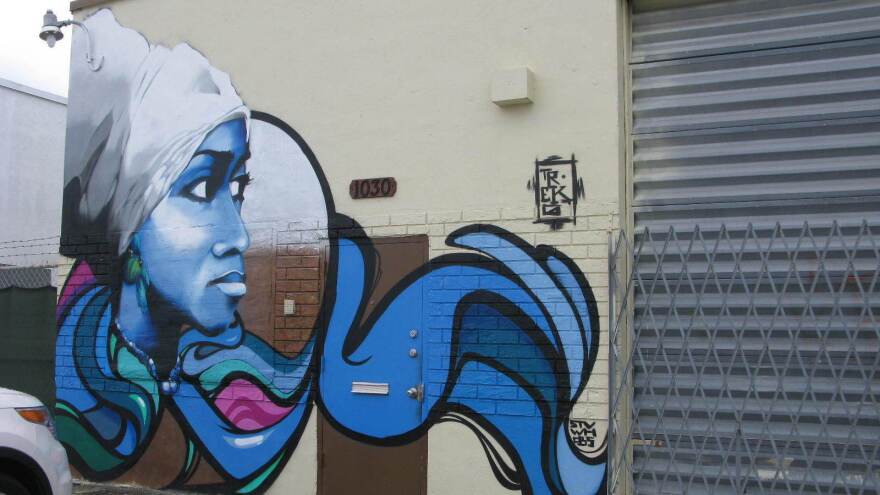Miami already enjoys a vibrant street art scene, but now a new arts district is emerging. The industrial city of Hialeah is becoming an affordable alternative for local artists, who are changing the area's reputation.
Colorful street art brightens the otherwise drab warehouses, where Cuban and Haitian immigrants labor inside binding books, making furniture and sewing clothes. The murals depict flamingoes, a fruit vendor, a girl celebrating her quinceañera.
One wall has the beautiful face of a Yoruba diety. The artist, who goes by the name Trek6, describes his spray-painted piece as a reflection of his hope for the area's future.

"This is a portrait of an orisha: Yemaya. She's the goddess of the ocean, to promote growth, fertility. And this area, it kinda needs that," he says.
The 40-year-old Puerto Rican artist says he wanted to represent part of his Caribbean culture.
"I want positivity here, I want nurturing here," he says. "And it's not for developers. This is what I want for the community."
Trek6 also has murals up in Miami's Wynwood area, a district created more than a decade ago by art dealers, artists, curators and real estate developers. That area now boasts dozens of galleries, museums, coffee shops and stores.
It's become completely unaffordable for many artists to live and work, says Hialeah City Councilman Paul Hernandez.
"They've been priced out of almost every single place that they've created," he says. "You'll have an area that was dirt cheap when all the artists came in, and all of a sudden you'll have a Gucci store next door and you can't afford it. Last week I saw this area in Wynwood ... it was about $410 a square foot, while here it's $5 a square foot."
The 27-year-old councilman grew up in Hialeah, which was once a thriving industrial corridor.
"This was a place that in the '80s and '90s was booming. I mean, we were probably the pinnacle of the garment industry for the entire state of Florida," he says. "My grandparents — everybody's grandparents was coming straight into these factories to work. With outsourcing, all of that went away."
Warehouses were left empty and Hernandez thought they'd be perfect for artists. Last spring, he began inviting them to work and live here. He promised the area would not get overdeveloped and would remain inexpensive. Hernandez had another goal: to change the city's reputation.

Since the early 1980s, graffiti writers have come to Hialeah to paint trains and warehouses with art illegally. And people like Jenny Molina have long flocked to the many thrift stores here.
But Molina says her hometown gets a bad rap.
"For a long time, it's always been the butt of every joke," she says. "If you see a sign with like a misspelled word, you'll see someone post it on Instagram or on social media and say, 'Oh, only in Hialeah.' You know, it's considered lowbrow, it's considered uneducated. And I can tell you from my own experience that that's not the case. It's a city of hardworking immigrant families."
Molina, a public relations rep for Trek6 and other artists, was tired of the jokes. She shared Hernandez' vision, so together they created this new arts district, what she calls a labor of love.
Last Sunday, they celebrated the new arts district with a block party, complete with music, poetry and food trucks. Molina and Hernandez say that's just the start for this area of Hialeah that's got a new nickname: Leah.
Copyright 2022 NPR. To see more, visit https://www.npr.org.




